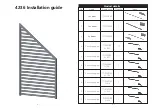
TOS8030
Remote Control 41
Fig. 6-4
Example: Circuit 3
•
Each gate is pulled up to +15 V. Opening the input terminals renders a state
equivalent to H-level input.
•
Consider i and i’ so that 5 mA or greater flows through Ic and Ic’.
•
To cancel a FAIL state, transmit a STOP signal of at least 20 ms in duration no
sooner than 100 ms after the generation of a FAIL signal, as indicated in Fig. 6-5.
Fig. 6-5
Timing of a STOP Signal
Countermeasures against noise
•
For elements connected to the tester, using photocouplers as shown in Fig. 6-4
or relays as shown in Fig. 6-3 appears to be advantageous, in that they are capa-
ble of reducing the incidence of noise-induced system malfunctions.
•
The internal control circuits of the tester has been designed to be resistant
against interference by noise generated by the tester and its peripheral devices.
However, it is not recommendable to connect non-shielded wires to the pins of
the REMOTE connector. Such wires may cause interference to the devices.
For the REMOTE connector, cables, and external circuits, use a shielded metal-
lic connector, shielded cables, and external circuits fabricated in a shielded cas-
ing. Connect the chassis of the tester to that of the external device.
This will isolate the REMOTE connector from the external environments and
will become more resistant against noise.
REMOTE Connector Input Conditions
H-level input voltage
11 V to 15 V
L-level input voltage
0 V to 4 V
L-level output-enable current
5 mA or less
Input time width
20 ms minimum
TOS8030
5
4
3
2
1
COM
START
20 ms or more
i
STOP
20 ms or more
iʼ
Icʼ
Photocoupler
turned on
Ic
REMOTE connector
FAIL
STOP
100 ms or more
20 ms or more
Содержание TOS8030
Страница 55: ......














































